Our research
Our research consists of 3 steps
Step 1
Birth
already participated
to this step
Parents interested in the study can participate at the East Limburg Hospital (ZOL) in Genk.
At the birth of your child, we then take the first step.
Just after the birth, you will receive a consent form and a questionnaire, after which we will collect the cord blood and placenta.
From the questionnaire, we can extract lifestyle habits and dietary patterns, as well as your exposure to environmental factors. In the placenta and umbilical cord blood, in turn, we can look for your baby's building blocks (such as DNA).
Two days after delivery, there is a routine blood collection from the mother. Here we collect an extra blood sample. You do not, therefore, need an extra puncture. The midwife will also ask you to collect a urine sample.
When your little sprout is 3 days old, we will pay you a visit. During this visit, one of our trained staff will visit both your blood pressure as measuring your baby's.
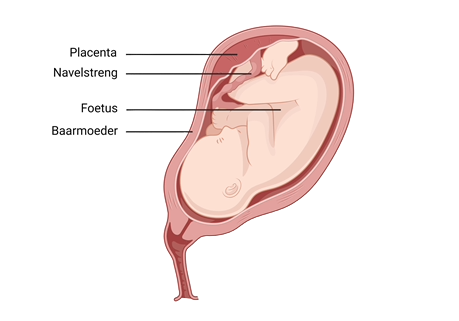
General questions you may have when participating
Why do I need to fill in a questionnaire?
To interpret the study correctly. This is because various factors can affect health. Therefore, we try to identify these as best we can through a questionnaire.
How will our data be handled?
The researchers process the information from the questionnaires, measurements and samples. Your child's name, yourself and your address will be replaced by a code. All information is treated confidentially in accordance with Belgian privacy legislation.
How do I benefit from this study?
Understanding the impact of environmental factors during pregnancy and early life on health, as well as the underlying molecular mechanisms, are essential to enable targeted prevention and standards policies that take into account a sensitive period in life. The integration of exposure data and molecular measurements should lead to better prediction of health risks in epidemiological studies.
The results of the study will be announced at group level, i.e. via a newsletter sent to you, as well as via this website. Should there be any abnormal results that are clinically interpretable, either in you or your child, they will be communicated to your GP by the researchers.
What if I no longer want to participate?
You have the right to stop your child's or yourself's participation at any time. Even if your child indicates that he or she no longer wishes to participate in the study, he or she has the right to stop his or her participation with immediate effect. You can also indicate whether the samples already collected may be kept or should be destroyed.
Doesn't blood pressure measurement in newborn children hurt?
Fortunately, the answer is "no". When your baby is 3 days old, one of our researchers will visit you. When your child is asleep, she will attach a blood pressure gauge to your baby's arm. The measurement is done while your little one is in dreamland. This causes the least discomfort for him/her.
I accidentally took the questionnaire home. What now?
Don't panic! Feel free to send the questionnaire to our postal address:
Hasselt University
Martelarenlaan 42
3500 Hasselt
For the attention of: Tim Nawrot
Step 2
4 to 6 years
already participated
to this step
In this step, we want to find out about your four-year-old sprout's development.
We look at your child's vascular health and neurological development.
In 2015, four years after starting Step 1 of the Limburg Birth Cohort, we started Step 2 of the study. In this step, we want to find out about your four-year-old sprout's development. We look at your child's vascular health and neurological development.
One of our staff will contact you asking if you wish to participate in this step. In order to conduct the examinations at your child's pace, we ask that you provide 1 to 1.5 hours. Examinations can be scheduled on Wednesday afternoons and all days during school holidays. Saturday appointments are also possible.
You and your child are always in the same room.
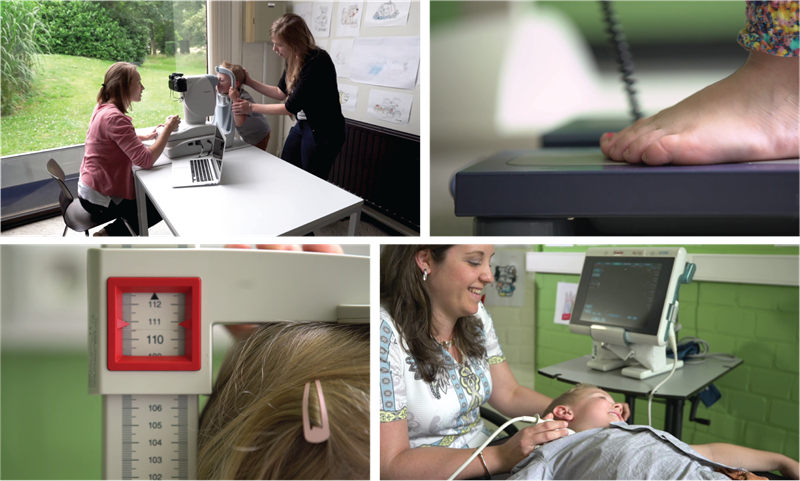
More information
Mother and child examinations
Jules also participated in the survey, and he thought it was super cool!
So he posed in front of our camera to present you with the surveys.
Height, weight and abdominal girth
As a first examination, we look at how big your child has grown and how much they weigh.

Heart rhythm
We stick a small device on your child's chest at the start of the examination.
This will record the heart rhythm during the entire examination.
Jules already thinks he is Iron Man with this flashing device!
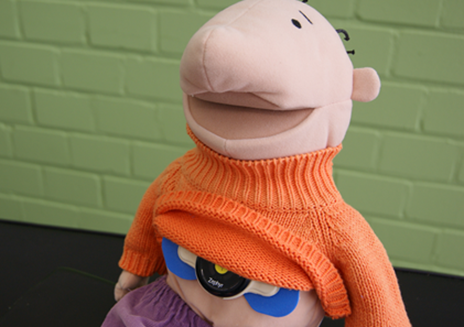
Blood pressure
In both you and your child, we take blood pressure five times.
Jules was very calm during the examination; he almost fell asleep on our bed.
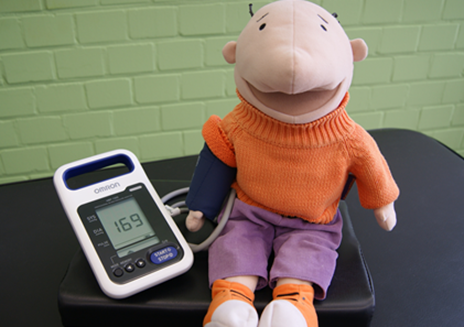
The very largest blood vessels
One of the body's largest blood vessels can be found in the neck: the carotid artery.
Through ultrasound, in both you and your child, we see how flexible this vein is.
Did you know that we use a special gel for this ultrasound to see your veins?
This gel is not the same as the one you smear in your hair, but just as slippery!
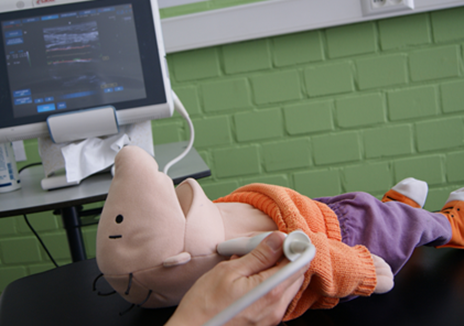
The very smallest blood vessels
One of the very smallest blood vessels is found in the eye (at the back of the retina).
We use a camera and a special lens with which we "look" right into the eye.
This is how we visualise these blood vessels, and see how healthy you and your child's blood vessels are.
Jules keeps looking for a green dot near the camera, will you help him look for it during the investigation?
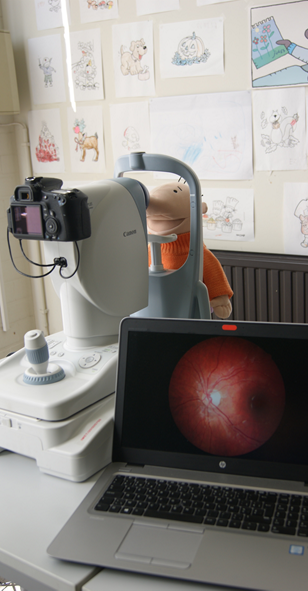
Responsiveness
We also test your child's responsiveness by playing various computer games.
These games explore how quickly your child responds to different stimuli, how well your child recognises different patterns, and how long he/she can concentrate.
Jules was able to find almost all the figures and he did it super fast on top of that. Are you faster than Jules?
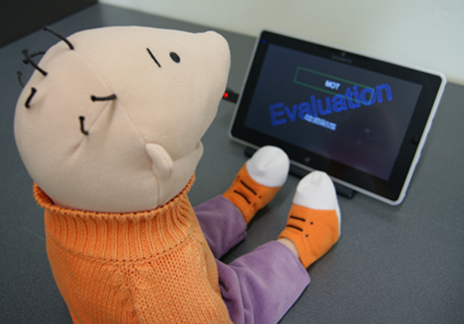
Route to step 2
Step 2 of our research continues in our research room at Campus Diepenbeek of Hasselt University:
Location of the University Campus, Building D
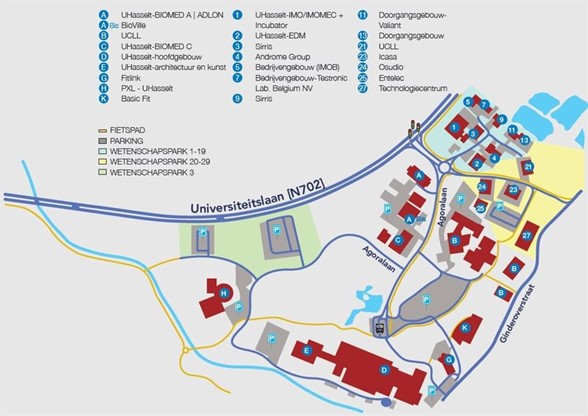
Parking for visitors
There is a dedicated car park reserved for Building D. Ring the bell at the front barrier, then park your car at the main building.
How can you reach our research office?
To reach our research room, enter through the main entrance, then take the corridor straight ahead and at the end left down the steps to H10.
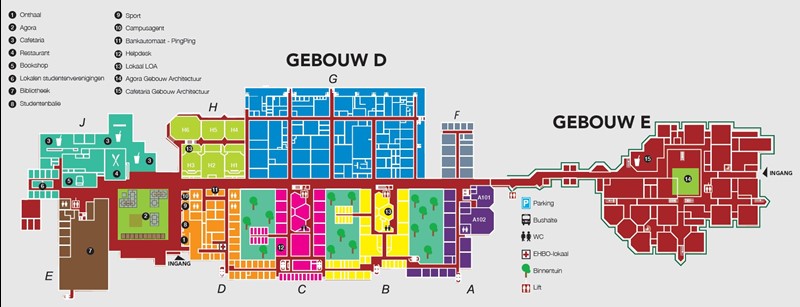
The researchers
The current research team for step 2 of our study consists of 4 permanent members: Yinthe, Hanne, Leen and Martien.
They will be happy to wait for you when you visit our research room.
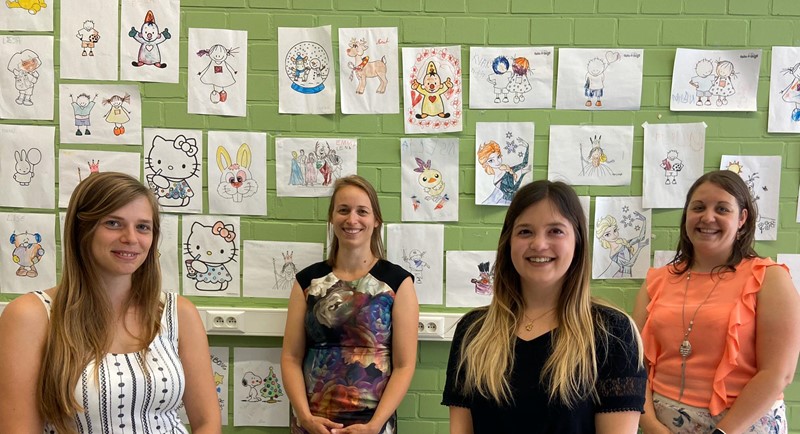
Step 3
9 to 11 years
already participated
to this step
Once again, we would like to invite you to a number of measurements we are conducting
according to the current health and development of your child and yourself.
In 2021, we started Step 3 of our research. Once again, we would like to invite you to a number of measurements that we will carry out according to the current health and development of your child and yourself. As in Step 2, we mainly focus on vascular health and neurocognitive development.
To already introduce your child to our research and the different measurements, we have a comic designed. Our stripper characters Juul and Marie are happy to provide some more information already.
More information
Mother and child examinations
The measurements we perform in our examination room are painless and will always be carried out in a child-friendly manner. You will also remain close to your child at all times during these measurements.
Height, weight and abdominal girth
To measure body height, a ruler will be used and a personal scale will measure body weight. Your child's abdominal girth will be measured with a tape measure.
Bone density measurement
To measure the density (strength) of your child's bone, an ultrasound probe will be used. A gel solution will be applied to the forearm. The ultrasound probe will then be moved over the forearm.
Vascular health
You and your child's blood pressure will be measured using an automatic blood pressure monitor.
To monitor your child's heart rhythm, three self-adhesive patches will be applied at the level of the chest.
To map the health of the blood vessels, a device similar to an automatic blood pressure meter will be used, only this device is much more sensitive, giving us more information about health. This measurement provides information about blood pressure at the level of the large body artery, the main blood vessel in our body. For this measurement, you and your child can take turns sitting supine on the examination table.
Finally, to assess the very smallest blood vessels in the body, a photograph of both eyes will be taken. A photograph will be taken of the blood vessels at the back of the eye. This will involve a noticeable flash of light similar to an ordinary camera flash.
Cognitive test
Your child will be given computer-based cognitive tests. These tests include various tasks assessing different areas of memory, such as short-term memory, attention and information processing. A camera will be placed on the computer to observe eye tracking movements while performing the cognitive tests.
Route to step 3
Step 3 of our research continues in our research room at Campus Diepenbeek of Hasselt University:
Location of the University Campus, Building D

Parking for visitors
There is a dedicated car park reserved for Building D. Ring the bell at the front barrier, then park your car at the main building.
How can you reach our research office?
To reach our research room, enter through the main entrance, then take the corridor straight ahead and at the end left down the steps to H10.

The researchers
The current research team for step 3 of our study consists of three permanent members: Eleni, Hanne and Thessa.
They will be happy to wait for you and your child and always proceed at your child's pace for taking measurements.

Research results
Presumably a lead for predicting diseases later in life. But whether that is really the case, and exactly what consequences are at stake, will have to become clear in the coming years. Therefore, be sure to participate in the following steps of our survey!
Do you also like to take a look at our results published in scientific articles? Then click here to view them!
